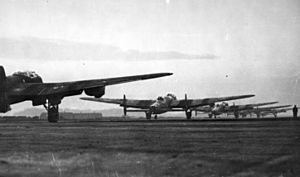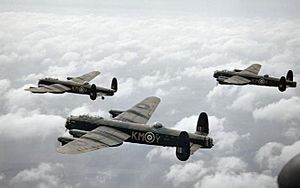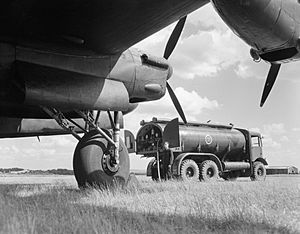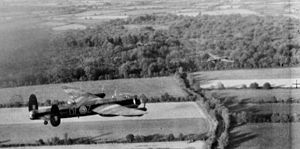Operation Robinson facts for kids
Quick facts for kids Operation Robinson |
|||||||
|---|---|---|---|---|---|---|---|
| Part of Second World War | |||||||
 Lancasters prepare to take off in the afternoon |
|||||||
|
|||||||
| Belligerents | |||||||
| Commanders and leaders | |||||||
| Strength | |||||||
| 94 Lancaster bombers | |||||||
| Casualties and losses | |||||||
| 1 aircraft crashed at the target, 7 aircrew killed |
63 French civilians killed | ||||||
| Schneider Works out of action for 3 weeks, under repair for 8 months. | |||||||
Operation Robinson was a special bombing mission carried out by the RAF during World War II. It happened on 17 October 1942, during the day. The target was the Schneider Works factory in Le Creusot, France. This mission was given to No. 5 Group, which used the new and powerful Avro Lancaster bombers. Everyone hoped these new planes would help the mission succeed.
Contents
Why This Raid Was Important
The Schneider Works was a very important factory in France. It made steel, locomotives (trains), artillery (big guns), and other armaments (weapons). People thought of it as France's version of Germany's famous Krupp Works factory. It was located in Le Creusot, in the middle of France. To reach it, planes had to fly about 300 miles over land controlled by the enemy.
Daylight Raids Were Risky
The RAF's Bomber Command usually bombed at night because daylight attacks were too dangerous. They had lost many planes in earlier daytime raids. However, many important factories that helped the German war effort were in countries that Germany had taken over. Bombing these factories at night could accidentally hurt many innocent civilians in those countries. Britain wanted to avoid this, especially in France, where people were trying to resist the German occupation. So, Bomber Command sometimes tried risky daylight attacks on specific targets, and the Le Creusot raid was one of them.
A similar daylight raid six months earlier against a German factory in Augsburg had gone very badly. Many planes were shot down, and the factory wasn't even damaged much. This showed how dangerous daylight raids could be. Everyone hoped the Le Creusot raid would not have such high losses.
Planning the Attack
Arthur Harris, the leader of Bomber Command, saw the Schneider factory as the most important target in France. To keep French civilians safe, the attack had to happen during the day. Luckily, the RAF had a new bomber, the Avro Lancaster. This four-engine plane could fly far, carry a lot of bombs, and was fast. It was hoped this new plane would make the raid successful.
A Tricky Flight Path
Flying a straight path to the target was too dangerous. German fighter planes were based in northern France and Belgium. The bombers would have no fighter escorts for most of the trip, making them easy targets. So, the plan was to fly a long way out over the ocean. They would then turn and approach the target from the west. The planes would fly very low to avoid being seen by German radar. They would leave in the afternoon, drop their bombs as it got dark, and then fly straight back home under the cover of night.
Only No. 5 Group RAF had enough Lancaster bombers ready. So, Arthur Harris assigned all nine squadrons from this group to the mission. In early October 1942, the crews started training. They practiced flying in formation and at very low altitudes. This was new for them, as they usually flew alone at high altitudes at night. The training was tough, and the crews wondered what their secret target would be. Several times, the mission was almost a go, with planes fueled and bombed up, but bad weather always caused it to be called off. Harris needed clear weather over Le Creusot to make sure the bombers could hit the factory accurately and avoid hurting French civilians.
Finally, on 17 October 1942, the weather was perfect. Operation Robinson was on!
The Raid Begins
94 Lancasters took off in the middle of the afternoon. They formed up in the sky before heading south over the ocean. Most of the planes (88 of them) were going to bomb the main factory. Six other planes were sent to a nearby town called Montchanin. Their job was to destroy a power station there that supplied electricity to the factory.
The group was led by Wing Commander L.C. Slee. Many famous squadrons were part of the raid, including 49 Squadron, 9 Squadron, and 44 Squadron. Guy Gibson, who would later become very famous, was leading 106 Squadron.
Flying Low and Fast
The bombers flew south over the Bay of Biscay at 1,000 feet. Then, they turned sharply, dropped down to just 100 feet, and headed towards France. They flew over an island, which might have warned the Germans. However, they didn't meet any German fighter planes when they reached the French coast. The Lancasters raced over 300 miles of French countryside, flying as low as the treetops. A few planes had minor damage from hitting birds, but there were no serious accidents.
The lead navigator, Pilot Officer A.S. Grant, guided the force perfectly to a key point near Nevers. From there, they made a slight turn and were on track for Le Creusot. For the last 60 miles, the planes climbed to different heights, from 2,500 to 7,500 feet, to drop their bombs. They arrived at Le Creusot at dusk. There was enough light to see the target clearly, but darkness was coming to cover their escape. They found almost no anti-aircraft guns (called Flak) over the target. The planes quickly flew over, dropping most of their bombs in about seven minutes. The six other Lancasters continued to Montchanin. Once their bombs were gone, the crews turned north and headed for home. Most crews reported that their bombing had been accurate. No planes were lost during the attack on the Schneider Works. However, at Montchanin, one Lancaster flew too low, hit a building, and crashed.
What Happened After the Raid
When the crews returned, they reported a successful attack. Guy Gibson's report called it "one of the greatest low-level daylight raids of the war." However, one of his flight commanders, Squadron Leader John Searby, later said that "Le Creusot was a profound disappointment."
It took a few days to get photos of the damage because of bad weather. Then, a photo-reconnaissance plane was shot down over the target. Eventually, another plane got the pictures. They showed that Searby's doubts were right. Many bombs had fallen short, hitting homes where workers lived. Still, there was a lot of damage to the factory's machine shops, steel mills, and a large warehouse that was completely destroyed.
Production at the Schneider Works stopped for three weeks. Repairs continued for eight months. The raid was well planned and executed in many ways. The navigation by Wing Commander Slee's navigator, Pilot Officer A.S. Grant, was perfect. He was even awarded a medal for guiding the planes so accurately over such a long distance and at low altitude.
However, the bombing itself wasn't as accurate as hoped. Experts thought this was partly because it was getting dark and smoke was covering the target. They also believed the bombing methods used were not right for daylight operations. The crews were used to bombing at night and didn't have enough training for complex daylight attacks. For example, they were told to climb and speed up just before dropping bombs, which made it hard to use their bomb sights correctly. Also, the planes didn't carry as many bombs as they could have. Later, the Lancaster's bomb-carrying ability was increased, and they would carry much heavier loads.




